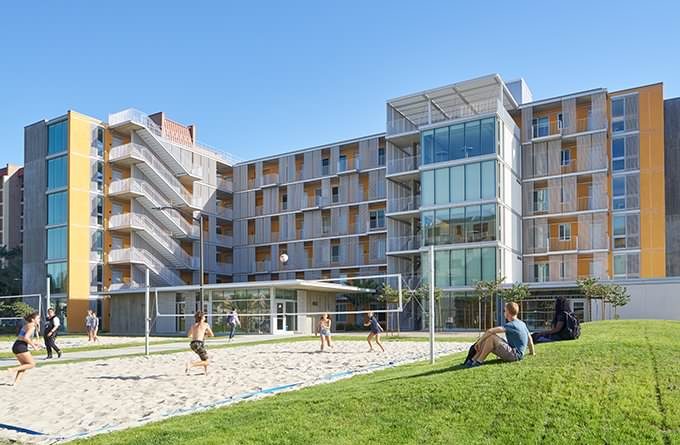Tenaya Towers Recognized with USGBC Merit Award
By Aziza Jackson
GOLETA, Calif. — Tenaya Towers at the University of California, Santa Barbara (UCSB) was recently honored at the 2018 Sustainable Innovation Awards. The project, a pair of six-story towers, received a Merit Award in the Energy and Atmosphere category. The Sustainable Innovation Awards (SIA) program is hosted by the U.S. Green Building Council’s Los Angeles chapter and recognizes projects that demonstrate exemplary performance that goes above and beyond standard rating systems.
Considered to be Los Angeles’ Oscars of green building, the SIAs affirm a project team’s commitment to a sustainable built environment and reflect the chapter’s emphasis on energy and water savings, air quality, good design, community engagement and equity. The SIAs are open to projects certified under any sustainability rating system.
“The Sustainable Innovation Awards recognize projects that go above and beyond credit achievement,” said SIA Co-chair Patti Harburg-Petrich of BuroHappold. “The project teams honored this year employed creative strategies that we hope will inspire the design and construction community to push the limits of standard practice. Thank you to all who submitted projects for consideration.”
Located on UCSB’s campus in Goleta, Calif. the Tenaya Towers provide space for student housing, study lounges, recreation rooms, and a market that is open to the school community as well as the public.
Tenaya Towers contain student housing and a convenience store that serves the university and adjacent community. Living areas open onto balconies that overlook an outdoor plaza, while bedrooms are situated away from outdoor activity. Study lounges and recreation rooms are centrally located to support academic and social life.
Perforated screens on the building facades provide shading, help keep the buildings cool, and serve as protective barriers. Larger openings in the screens enhance daylighting and views. Additional screens on operable windows in bedrooms and study lounges provide shading and act as guardrails for each unit. A freestanding pavilion in the plaza contains a recreation room and study lounge for students.
The towers define a central outdoor plaza that total 105,000 square feet, Certified LEED Platinum, the towers feature natural ventilation, rooftop solar hot water collectors, and greywater use. Sustainable features in the site plan include a stormwater management system with bioswales, bio-retention and mechanical filters to protect adjacent wetlands, and ground cover with drought-tolerant plants.
Tenaya Towers also features natural ventilation, rooftop solar hot water collectors, and greywater use. The building envelopes are carefully designed to maximize thermal performance, contributing to energy consumption that is 20 percent below California’s Title 24 baseline. The efficient use of building materials also helped reduce the project’s carbon footprint.
The Tenaya Towers are part of the UCSB San Joaquin Apartments and Precinct Improvements Project, a campus master plan led by Skidmore, Owings & Merrill, LLP (SOM). SOM worked together with three other architecture firms to design the various residences and dining commons—a collaborative approach that infuses the project with architectural diversity. SOM’s Los Angeles office designed Tenaya Towers, Lorcan O’Herlihy Architects and Kevin Daly Architects designed additional residential complexes, and Kieran Timberlake designed the dining commons.
Harper Construction, BuroHappold, Stantec, Sherwood Design Engineers, Tom Leader Studio, Horton Lees Brogden Lighting Design, Newson Brown, and Jensen Hughes are also listed as part of the project team.
“The projects and people honored by the Sustainable Innovation Awards exemplify thought leadership and creativity in their design solutions to site and building challenges,” said SIA Co- chair Amelia Feichtner of the City of Santa Monica. “It is inspiring that our community is advancing sustainability in a wide range of project scales and in both private and public development.”

